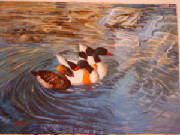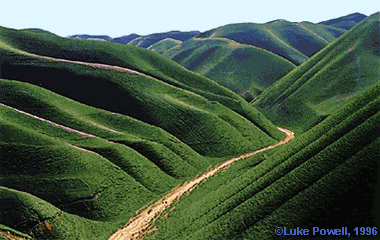|

          
|
Cotton and wool are the main material used in Afghanistan.The men wear a thigh-length, long-sleeved shirt which is belted at the waist with a skirt effect to the lower half. A sleeveless waistcoat is worn over the shirt and there are loose fitting white trousers. Another form of dress is the long-sleeved, ankle-length 'chupan'. This is a long coat made in wool, often white in color and worn by the mountain people in the winter season. The chupan is worn over loosely fitting jackets and trousers, or is wrapped round the body like a cloak. Women wear the Chadri, which covers a woman from head to foot, with a latticed slit for the eyes, is made of cotton in shades of blue, brown, black. In the rural parts, women working on the land dispense with this, but cover their faces in the presence of a stranger. The women near Pakistan's border wear long, full trousers, often red in color, with a loose, long-sleeved tunic dress, rather like the kameez, together with a draped head scarf. This is the basis of many of the women's costumes and the tunic varies in length and design. In the northern areas striped material is used, often dyed red from madder or in shades of blue and brown. Loose sleeveless, hip-length jackets are worn in full-length striped coat for warmth. A white head scarf signifies the married status. In the winter, thick woolen, hand-knitted stockings are worn with leather boots. Children and adults wear sandals or a form of boot as protection against the rough mountainous ground or earth. The hide comes from the Yak, which is found throughout the highlands of central Asia. In the cities, the open toe sandals is very common and sometimes shoes with up-pointed toes are seen. Afghan Sport:-: Bozkushi is a game that dates itself into Afghan antiquity. The name bozkushi, literally translated means "goat killing" suggest it was derived from hunting mountain goats by champions on horseback. Today the rider (or team) who is able to pitch a dead calf across a goal line first wins. The game may last as long as a week and is as free-wheeling as the Afghan spirit. Bozkushi horses require special
training in order to be successful in the game. Should the rider be thrown or dismount, the horse waits. A trained horse will
gallop with terrific speed as soon as the horseman snatches the areas of a calf in order to gain an edge in the game. The
horses are said toenjoy the game as much as the riders. Bozkushi horses are fed oats at regular intervals. A few days prior to bozkushi, the trainer keeps the horse hungry for part of the day and rides it daily a fairly long distance. This is meant to soften the horse and make it slightly lean to avoid busting when under excessive strains. Horsemen call their animals after their natural color. For instance, a grey horse is called "t'Aragh"; an ash blond horse is referred to as "samand"; a red horse as "jayran"; and a white one as "qezel" or "boze". Bozkushi horsemen wear thick hats, quilted dresses, long boots and wind strong scarves around their waists. .:: More Coming Soon ::. |
|
|||||||||||||||||||||||||||||||||
|
[ Go to Top ]
. 
|
|||||||||||||||||||||||||||||||||||








 The price of trained horses range Afs. 20,000 and Afs. 100,000 in pre-jihad Afghanis. If one was to pay in a more valuable
international currency, they could be had today for between $700.00 and $2,500.00.
The price of trained horses range Afs. 20,000 and Afs. 100,000 in pre-jihad Afghanis. If one was to pay in a more valuable
international currency, they could be had today for between $700.00 and $2,500.00.